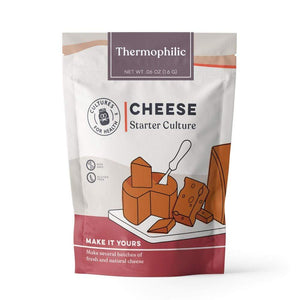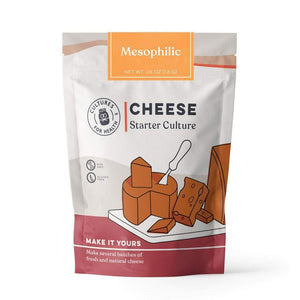
This cheese is a hard, grating variety. It can be used also as a slicing cheese if aged for only up to 3 months. If aged between 6 months to a year, it becomes a hard, crumbling cheese much like parmesan. This cheese is traditionally made with skim milk, and can also be made with half skim goat milk and half skim cow milk to increase the sharp flavors. Making the cheese with regular whole cow milk works well, though, and imparts a milder flavor.
20 minutes
180 minutes
4
INGREDIENTS AND EQUIPMENT AVAILABLE AT CULTURES FOR HEALTH
Thermophilic Starter Culture

Thermophilic Starter Culture
$12.99
This useful culture makes a variety of hard cheeses, including parmesan, romano, provolone, and swiss.
Mesophilic Direct-Set Starter Culture

Mesophilic Direct-Set Starter Culture
$14.99
From cheddar, Colby, and Monterey Jack to Feta, Chevre, and more, you'll enjoy the flavor and variety of homemade cheeses made using this starter culture.
INGREDIENTS:
- 2 gallons whole milk
- 1 packet direct-set thermophilic starter
- 1/2 packet direct-set mesophilic starter
- 1 tsp. liquid rennet diluted in 1/4 cup unchlorinated water
- Cheese salt (about 2 Lbs. , for brine)
- Unchlorinated, cool water for brine
INSTRUCTIONS:
- Heat milk indirectly to 88°F. Add both the mesophilic and thermophilic cultures by sprinkling them atop the milk and allowing them to rehydrate for 1 full minute, then stirring them in with your cheese spoon in steady, up-and-down strokes.
- Cover the milk and allow to ripen for 1 hour, undisturbed. Use a thermometer to ensure the milk’s temperature remains at 88°F. If the temperature falls, use the indirect heating method to bring the temperature back up before moving on.
- Add the diluted rennet by pouring it through the cheese spoon holes and into the milk, stirring in steady up-and-down motions for 1 full minute to incorporate thoroughly. Cover the milk and allow to set for 30 minutes or until the curds give a clean break.
- Cut the curds into 1/4-inch cubes using a clean curd knife.
- Reheat the curds to 102°F, raising the temperature slowly by only 2°F every 5 minutes. Stir the curds regularly but gently with the cheese spoon to prevent them from matting. Once temperature has been reached, maintain it for 1 hour, continuing to stir frequently.
- Drain off whey until you can just see the tops of the curds. Add very hot filtered water to the curds and whey until the overall temperature reaches 110°F. Maintain this temperature for 10 minutes, stirring the curds consistently to prevent any matting. Drain off the whey and water when the 10 minutes is over.
- Line a 2-Lbs.cheese press with damp butter muslin. Quickly begin scooping the hot curds into the press. Position the follower and press the curds at 5 pounds of pressure for 15 minutes.
- Take the cheese out of the press and undress it. Flip it over and re-dress, then place back into the press at 5 pounds of pressure for 30 minutes.
- Remove, undress, flip and re-dress the cheese, and press at 10 pounds of pressure for 12 hours.
- Meanwhile, in a large plastic pitcher or bowl with a lid, make a saturated brine (32-ounces of salt to 1 gallon of water and chill it in the refrigerator.
- Remove the cheese from the press and soak in the chilled brine for 6 hours at room temperature.
- Take the cheese out of the brine and pat it dry with paper towels. Filter and save the brine for other uses.
















